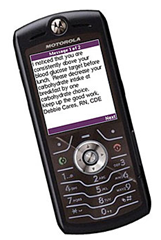You know what will radically improve patient lives? Universal healthcare, access to housing, paid childcare, better public transport. Improve a…
Monday Morning Update 12/8/08
From Bucky DeVol: "Re: ONCHIT. The Halamka rumors are not true. He might be talking to Daschle’s people, but he’s not going to DC." He’s leading in the poll to your right, although Dan Nigrin has been written in three times (he swears someone is doing that as a joke – Inga asked him about it from an earlier reader’s comment). Other write-in nominees include Jeannie "Bill becomes a Law" Patterson (sic), Charlie McCall, and Justen Deal. You people are fun.
From Steve-O: "Re: stories you cover. How do you decide what goes in HIStalk?" I include whatever interests me as someone working in hospital IT every day, which hopefully also interests you as well. Grade me: over the past month, what useful information did you get from what sources? I pick what you can use, summarize ruthlessly, get it to you fast, and encourage reader feedback to add value. I also go after stuff that nobody else is talking about and filter out the 99% of BS "news" that nobody cares about. You’re the ultimate judge, though, since the only person I know I please 100% of the time is me.
New to your right: I installed the Google Friend Connect social networking app. It looks interesting, especially as they roll out new widgets. Give it a try if you like.
The Charlie McCall nominee got me going, so I found this book that has his endorsement from him back in his pre-HBOC CompuServe days: "To survive and succeed in a decade of rapidly changing technologies and increasing global competition for service companies, we must strive to ‘change the rules of the game.’" Your punchline is as good as mine.
Listening: Flyleaf, sweet chick rocker warbling with a positive message (check the video of their World Vision trip to Rwanda and the bio of the lead singer). Very nice.
Carondelet St. Mary’s (AZ) goes live on Amelior EDTracker integrated with ultrasound asset tracking from Sonitor Technologies.
HSW International acquires 14-employee DailyStrength in what TechCrunch calls a "mercy acquisition". It’s one of many Rounded Arial sites that hoped to become the MySpace for health with a mixture of good intentions and profit motive, although it seems deceiving to run a VC-funded dot-com under a .org address.
I mentioned Gartner’s EMR report for the VA and DoD that said only Epic and Cerner could meet their needs. If someone has a copy of that report, please send it my way. It’s important: vendors and DoD are pushing for proprietary vendor solutions, while the VA’s unparalleled success with open source, standards-based VistA makes it wary of that approach (but the VA, apparently, is badly outnumbered). Open source is already a mere footnote to the hospital systems business and losing its VA poster child makes it irrelevant, unfortunately, even though non-adopters always cite cost as the main reason they stick with manila folders.
Tim Clover, CEO of T+ Medical, added a comment to the mention here about discontinuation its trial by the Norfolk and Norwich University Hospital for diabetes care, saying my mention was inaccurate. Which it was, at least through omission: I referenced the use of the product in general and later noted a story saying the hospital had stopped using it, but I didn’t mention that it’s being successfully used by a several others. He should have just e-mailed me, but I’ll overlook that by approving his comment that plugs the product.
Mark Tepping, CIO of Bridgeport Hospital and a 35-year member of HIMSS, tells me he’s retiring. Food for thought: his wife, a former neuro nurse, said the spouses of patients often expressed regret at waiting too long to do all the things they planned together, so he’s not making that mistake. He’ll send over an e-mail address for anyone who wants to get in touch.

Original Version – Google Cache
Curious: above are the original (from Google’s cache) and current (from the HIMSS site) versions of the HIMSS press release referring to the organization (for the first time ever, as far as I can tell) as a trade association. That troublesome phrase has been quietly expunged. I guess we still don’t know if it is or not.
We’ll be introducing some guest writers and some fun "HIT Moment With …" subjects shortly in our never-ending effort to make HIStalk more useful. It will be time for the HISsies and HIMSS-related activity before you know it! If you want to get involved in some way or have suggestions, shoot me an e-mail (although remember I work a zillion hours a day between my job and HIStalk, so I’m always in catch-up mode).
USP gets out of the medication error reporting business, sending MedMarx off to Quantros and MERP to ISMP (that’s a lot of acronyms, but if you don’t know what they mean, the story won’t interest you anyway).
Housekeeping: plunk your e-mail in the Subscribe to Updates box to your right to help knock my server offline as it tries to simultaneously deliver e-mail updates to 3,302 people at once. Make it even worse by clicking on the Email This to a Friend graphic right below it to tell a few pals about HIStalk. The Google-powered Search function roots through 5.5 years and many millions of words of HIStalk to find whatever interests you (yourself, your company, or your hated rival). Click the crude Report a Rumor to Mr. HIStalk graphic to send me confidential info anonymously.
Microsoft convenes a healthcare provider symposium in Redmond, talking up its "partner ecosystem." I’m not sure that touting a partner’s Visio add-in for analyzing patient flow shows a lot of innovation and leadership, but I wasn’t at the meeting.
An AHRQ-funded article in Annals of Emergency Medicine doesn’t inspire a lot of confidence. Respondents from 65 hospitals reported insufficient space, too many patients to care for properly, and inadequate access to computers and electronic medical records (I can only see the summary since I don’t subscribe).
Hospital layoffs: Yakima Regional Medical and Cardiac Center (WA), Carlisle Regional Medical Center (PA), University of Toledo Medical Center (OH).
Nurses at Lawrence Memorial Hospital (MA) are doing a study to see if music calms patients waiting for endoscopies. They’re using Internet streaming radio from Pandora to choose music that the patient likes instead of the usual Muzak. I suggest HIStalk Radio, although patients might clench up from some of the hardcore tunes (playing now: Union Carbide Productions, Noir Desir, and the Blue Stingrays).
Civilians treated at the Yokota Air Base hospital in Japan weren’t billed because the Coding Compliance Editor software wasn’t set to send bills without human intervention.
London hospitals want NHS to compensate them for unplanned legacy system maintenance needed because NPfIT is years behind.
Nuance announces Q4 results: revenue up 41%, EPS $0.09 vs. -$0.02. Nice. A conference call comment supports what I’ve been saying about hospitals insisting on non-capital ways of buying systems (or, more precisely, expected system benefits): "We are finding customers, even some of our larger hospital customers, who express preference for a subscription pricing or a transaction-based pricing, a form of leasing in effect, rather than an upfront capital payment. As we said in the prepared comments, we benefit from that over time. It’s economically superior to us over time but it does have a different revenue stream over the course of this year." Everybody benefits except those companies on too shaky financial ground to make the transition to stretched-out payments, so subscription pricing will definitely be used by big vendors to outsell smaller ones whose products may be superior. You have been warned.
Vendor Deals and Announcements
- CPSI announces its 100th sale of its PACS solution ImageLink.
- Deb Bradley is D2Hawkeye’s new VP, Chief Client Solution Executive. Bradley has spent the last 13 years at Trizetto, serving as VP of Product Management, VP of Sales Support, and Director of Care Management roles.
- Maxell Medical Imaging (NY) selects Aspyra’s Access RAD RIS/PACS solution.
- Phoenix-based DiCOM grid, Inc. announces that Michael V. Wall is its new CEO. Wall previous worked for Intel, Cray Research, and IBM.
- Children’s Hospital of Philadelphia contracts with Acuo Technologies for a new archiving solution that will become the basis of CHOP’s medical imaging management platform.
- gMed releases (warning: PDF) a gastro-specific EMR named gGastro.
- Nuance reveals a new on-demand solution named Veriphy 3.0, designed to help healthcare provider organizations communicate test results. Nuance also announces it has integrated its RadWhere radiology application with DeJarnette Research System’s PACSware Intelligent Router product.
- Mediware’s blood and medication management systems will be installed across 40 South African hospitals as part of an agreement with the Provincial Government of the Western Cape.
- Associated Cardiovascular Associates (NJ) picks Sage Software Healthcare’s Intergy EHR/PM solution for its 38 doctor practice.
- VMware is now successfully deployed at St. Vicent Catholic Medical Centers of New York.
- Emdeon premieres a new US Healthcare Efficiency Index to monitor healthcare business efficiency as the industry moves away from paper. Phase 1 of the Index estimates the total annual savings potential to be nearly $30 billion for medical claims-related transactions. The Index also suggests that the direct deposit of medical payments could provide an $11 billion annual savings.
- Consulting firm HighPoint Solutions adds a new Quality and Compliance practice to address the increased regulatory requirements and related information technology issues in the life sciences industry.
- Eric Silfen, MD is named the new (and first) chief medical officer and VP of Philips Healthcare. Silfen was previously in the department of biomedical informatics research at Philips Research North America, and also spent time working for HCA.
- Orion Health’s Rhapsody integration engine will be employed for the SouthEast Alaska Regional Health Consortium. Rhapsody will link healthcare information across 18 remote Alaska Native communities.
- The Hawaii Medical Service Association is launching a new online care service that will connect patients and physicians via the Internet or telephone. The cost of a visit will be $10 for members or $45 for nonmembers.
- Baptist Health (AR) claims to have realized over $1 million in savings since implementing Thomson Reuters’ Clinical Xpert CareFocus. The CareFocus solution has improved pharmacist efficiency and increased documented clinical interventions by about 30%.
- The state of New Jersey is bailing out six financially distressed NJ hospitals where access to health care services is threatened. A total of $44 million will be distributed to provide care for the uninsured and low-income residents. About half of the money went to Jersey City Medical Center.
- MedCurrent Corporation introduces a new Web-based, real-time insurance eligibility verification application that is being targeted to radiology practices. Currently the MedCurrent Verify program will connect with over 350 insurers.
- Medical Imaging Northwest (WA) is teaming up with Compressus to implement a single enterprise-wide worklist solution that integrates digital imaging and data management systems at its multiple sites.






CCHIT *sunk* the OSS medical software opportunity. It should surprise no one when a group of vendors gets together to create a certification process. Dr. Borges, care to elaborate? 🙂
Hi Jupiter:
I agree wholeheartedly. Actually we all need to read the **fantastic** article from ZNET on CCHIT on 12/1/2008-
“To CCHIT or not to CCHIT is the question”
URL: http://healthcare.zdnet.com/?p=1559
Closing statement-
————————————————
“No single vendor or certification process can build an IT infrastructure that both enables innovation and distributes it universally. But standards can. Open standards, offered royalty-free as they are through the World Wide Web Consortium, can do that. That is my model for what the CCHIT can and should become. If it doesn’t want to do that, it [CCHIT] should either go away or be ignored.”
————————————————-
I still say that it should go away and be ignored now- no preconditions are necessary. It’s a competition stifling company with a not-for-profit facade put together to enrich the “enterprise” EMR vendors through numerous mechanisms.
Al
Not sure if VistA is truly “open source” since they don’t really feed in enhancements from the outside world last I checked, and those using it need to monitor enhancements published by VA to make sure they don’t clobber something locally developed. But, this is a nerdy nit-pick. And, in the long run internal VistA gets eventually steamrolled by the Washington lobbyist efforts on behalf of large vendors anyway. I’m not sure how impartial Gartner is…
I wish CCHIT would focus on certifying compliance with HITSP standards. As it currently operations, CCHIT is only relevant to EMR vendors by CCHIT’s definition which is well outside what many in HIT worry about…
Congratulations to Mark Tepping on his decision to retire. I know that I am one of many that will miss Mark’s ‘positive cynicism’ and wonderful wit. He is one of those wonderful people that has exerted an incredibly positive influence on our industry in a valuable, yet humble way. I wish him well…but at the same time I will miss his intellect, guidance and friendship.
In the September 17th, 2008 Gartner report #G00161139 entitled North American Enterprise CPR Generation Evaluation… it stated
Key Findings
• Three vendor offerings (Cerner, Eclipsys and Epic) have achieved Generation 3 status,
with several others only narrowly missing this milestone.
• The critically important areas of controlled medical vocabulary (CMV), clinical workflow
and clinical decision support are still lagging behind the other CPR capabilities.
• Given the slower-than-expected rate of development and implementation, it is unlikely
that the first Generation 4 product will appear by 2010, as initially anticipated.
re: ONCHIT- I believe ONCHIT coordinator is a federal, career posting, and that Dr. Kolodner expects to remain after Jan 21st (heard from a well-connected source).